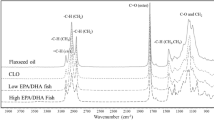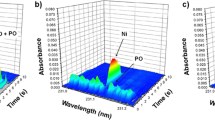Abstract
Following the recent success in quantitative analysis of essential fatty acid compositions in a commercial microencapsulated fish oil (μEFO) supplement, we extended the application of portable attenuated total reflection Fourier transform infrared (ATR-FTIR) spectroscopic technique and partial least square regression (PLSR) analysis for rapid determination of total protein contents—the other major component in most commercial μEFO powders. In contrast to the traditional chromatographic methodology used in a routine amino acid analysis (AAA), the ATR-FTIR spectra of the μEFO powder can be acquired directly from its original powder form with no requirement of any sample preparation, making the technique exceptionally fast, noninvasive, and environmentally friendly as well as being cost effective and hence eminently suitable for routine use by industry. By optimizing the spectral region of interest and number of latent factors through the developed PLSR strategy, a good linear calibration model was produced as indicated by an excellent value of coefficient of determination R 2 = 0.9975, using standard μEFO powders with total protein contents in the range of 140–450 mg/g. The prediction of the protein contents acquired from an independent validation set through the optimized PLSR model was highly accurate as evidenced through (1) a good linear fitting (R 2 = 0.9759) in the plot of predicted versus reference values, which were obtained from a standard AAA method, (2) lowest root mean square error of prediction (11.64 mg/g), and (3) high residual predictive deviation (6.83) ranked in very good level of predictive quality indicating high robustness and good predictive performance of the achieved PLSR calibration model. The study therefore demonstrated the potential application of the portable ATR-FTIR technique when used together with PLSR analysis for rapid online monitoring of the two major components (i.e., oil and protein contents) in finished μEFO powders in the actual manufacturing setting.





Similar content being viewed by others
References
Aghbashlo, M., Mobli, H., Madadlou, A., & Rafiee, S. (2012). Influence of wall material and inlet drying air temperature on the microencapsulation of fish oil by spray drying. Food and Bioprocess Technology. doi:10.1007/s11947-012-0796-7.
Augustin, M. A., & Sanguansri, L. (2010). Use of encapsulation to inhibit lipid oxidation. In E. Decker, R. Elias, & D. J. McClements (Eds.), Oxidation in foods and beverages and antioxidant applications (pp. 479–495). Cambridge: Woodhead Publishing.
Barron, C. (2011). Prediction of relative tissue proportions in wheat mill streams by Fourier transform mid-infrared spectroscopy. Journal of Agricultural and Food Chemistry, 59, 10442–10447.
Barrow, C. J., Nolan, C., & Jin, Y. (2007). Stabilization of highly unsaturated fatty acids and delivery into foods. Lipid Technology, 19(5), 108–111.
Barth, A. (2000). The infrared absorption of amino acid side chains. Progress in Biophysics and Molecular Biology, 74, 141–173.
Borza, A. D., Annan, N. T., Moreau, D. L., Allan-Wojtas, P. M., Ghanem, A., Rousseau, D., et al. (2010). Microencapsulation in genipin cross-linked gelatine-maltodextrin improves survival of Bifidobacterium adolescentis during exposure to in vitro gastrointestinal conditions. Journal of Microencapsulation, 27(5), 387–399.
Burdge, G. C., & Calder, P. C. (2005). Conversion of α-linolenic acid to long-chain polyunsaturated fatty acids in human adults. Reproduction Nutrition Development, 45, 581–597.
Byler, D. M., & Susi, H. (1986). Examination of the secondary structure of proteins by deconvolved FTIR spectra. Biopolymers, 25, 469–487.
Cai, S., & Singh, B. R. (2004). A distinct utility of the amide III infrared band for secondary structure estimation of aqueous protein solutions using partial least squares methods. Biochemistry, 43, 2541–2549.
Choy, J.-H., Shin, J., Lim, S.-Y., Oh, J.-M., Oh, M.-H., & Oh, S. (2010). Characterization and stability analysis of zinc oxide nanoencapsulated conjugated linoleic acid. Journal of Food Science, 75(6), N63–N68.
Cohen, S. A. (2001). Amino acid analysis using precolumn derivatisation with 6-aminoquinolyl-N-hydroxysuccinimidyl carbamate. In C. Cooper, N. Packer, & K. Williams (Eds.), Methods in molecular biology (pp. 39–47). Totowa, NJ: Humana Press.
Cohen, S. A., & De Antonis, K. M. (1994). Applications of amino acid analysis derivatisation with 6-aminoquinolyl-N-hydroxysuccinimidyl carbamate: analysis of feed grains, intravenous solutions and glycoproteins. Journal of Chromatography. A, 661, 25–34.
Cohen, S. A., & Michaud, D. P. (1993). Synthesis of a fluorescent derivatizing reagent, 6-aminoquinolyl-N-hydroxysuccinimidyl carbamate, and its application for the analysis of hydrolysate amino acids via high performance liquid chromatography. Analytical Biochemistry, 211, 279–287.
Dong, A., Huang, P., & Caughey, W. S. (1990). Protein secondary structures in water from second-derivative amide I infrared spectra. Biochemistry, 29, 3303–3308.
Geladi, P., & Kowalski, B. R. (1986). Partial least-squares regression: a tutorial. Analytica Chimica Acta, 185, 1–17.
Goutte, C. (1997). Note on free lunches and cross-validation. Neural Computation, 9(6), 1245–1249.
Guillen, M. D., & Cabo, N. (1997). Characterization of edible oils and lard by Fourier transform infrared spectroscopy. Relationships between composition and frequency of concrete bands in the fingerprint region. Journal of the American Oil Chemists' Society, 74, 1281–1286.
Jones, P. J. H., & Kobow, S. (1999). Lipids, sterols, and their metabolites. In M. E. Shils, J. A. Olson, M. Shike, & A. C. Ross (Eds.), Modern nutrition in health and disease (9th ed., pp. 67–94). Baltimore: Williams & Wilkins.
Kadamne, J. V., Castrodale, C. L., & Proctor, A. (2011). Measurement of conjugated linoleic acid (CLA) in CLA-rich potato chips by ATR-FTIR Spectroscopy. Journal of Agricultural and Food Chemistry, 59, 2190–2196.
Kansiz, M., Schustera, K. C., McNaughton, D., & Lendl, B. (2005). Sequential Injection/mid-infrared spectroscopic analysis of an acetone-butanal-ethanol fermentation: analyte cross correlation effects. Spectroscopy Letters, 38, 677–702.
Kohler, A., Kirschner, C., Oust, A., & Martens, H. (2005). Extended multiplicative signal correction as a tool for separation and characterization of physical and chemical information in Fourier transform infrared microscopy images of cryo-sections of beef loin. Applied Spectroscopy, 59(6), 707–716.
Kohler, A., Afseth, N. K., & Martens, H. (2010). Chemometrics in biospectroscopy. In J. Chalmers, E. C. Y. Li-Chan, & P. R. Griffiths (Eds.), Applications of vibrational spectroscopy in food science (pp. 89–106). Chichester, UK: Wiley.
Kralovec, J. A., Zhang, S., Zhang, W., & Barrow, C. J. (2012). A review of the progress in enzymatic concentration and microencapsulation of omega-3 rich oil from fish and microbial sources. Food Chemistry, 131, 639–644.
Locher, F., Heuwinkel, H., Gutser, R., & Schmidhalter, U. (2005). The legume content in multispecies mixtures as estimated with near infrared reflectance spectroscopy: method validation. Agronomy Journal, 97, 18–25.
Maggio, R. M., Kaufman, T. S., Del Carlo, M., Cerretani, L., Bendini, A., Cichelli, A., et al. (2009). Monitoring of fatty acid composition in virgin olive oil by Fourier transformed infrared spectroscopy coupled with partial least squares. Food Chemistry, 114, 1549–1554.
Martens, H., Nielsen, J. P., & Engelsen, S. B. (2003). Light scattering and light absorbance separated by extended multiplicative signal correction. Application to near-infrared transmission analysis of powder mixtures. Analytical Chemistry, 75, 394–404.
Miyazawa, T., & Blout, E. R. (1961). The infrared spectra of polypeptides in various conformations : amide I and II bands. Journal of the American Chemical Society, 83, 712–719.
Naes, T., Isaksson, T., Fearn, T., & Davies, T. (2002). A user-friendly guide to multivariate calibration and classification. Chichester, UK: NIR Publications.
Payne, K. J., & Veis, A. (1988). Fourier transform IR spectroscopy of collagen and gelatin solutions: deconvolution of the amide I band for conformational studies. Biopolymers, 27, 1749–1760.
Perisic, N., Afseth, N. K., Ofstad, R., & Kohler, A. (2011). Monitoring protein structural changes and hydration in bovine meat tissue due to salt substitutes by Fourier transform infrared (FTIR) microspectroscopy. Journal of Agricultural and Food Chemistry, 59, 10052–10061.
Savitzky, A., & Golay, M. J. E. (1964). Smoothing and differentiation of data by simplified least squares procedures. Analytical Chemistry, 36, 1627–1639.
Schönbrodt, T., Mohl, S., Winter, G., & Reich, G. (2006). NIR spectroscopy—a non-destructive analytical tool for protein quantification within lipid implants. Journal of Controlled Release, 114, 261–267.
Silverstein, R. M., Blaser, G. C., & Morril, T. C. (1974). Spectrometric identification of organic compounds (3rd ed.). New York: Wiley.
Sun-Waterhouse, D., Wadhwa, S. S., & Waterhouse, G. I. N. (2012). Spray-drying microencapsulation of polyphenol bioactives: a comparative study using different natural fibre polymers as encapsulants. Food and Bioprocess Technology. doi:10.1007/s11947-012-0946-y.
van de Weert, M., Van't Hof, R., Van der Weerd, J., Heeren, R. M., Posthuma, G., Hennink, W. E., et al. (2000). Lysozyme distribution and conformation in a biodegradable polymer matrix as determined by FTIR techniques. Journal of Controlled Release, 68(1), 31–40.
Vongsvivut, J., Heraud, P., Zhang, W., Kralovec, J. A., McNaughton, D., & Barrow, C. J. (2012). Quantitative determination of fatty acid compositions in micro-encapsulated fish-oil supplements using Fourier transform infrared (FTIR) spectroscopy. Food Chemistry, 135, 603–609.
Wang, N., Fu, Y., & Lim, L.-T. (2011). Feasibility study on chemometric discrimination of roasted arabica coffees by solvent extraction and Fourier transform infrared spectroscopy. Journal of Agricultural and Food Chemistry, 59, 3220–3226.
Williams, P. C. (2001). Implementation of near-infrared technology. In P. Williams & K. Norris (Eds.), Near Infrared Technology in the Agriculture and Food Industries (2nd ed., pp. 145–169). St. Paul, MN: American Association of Cereal Chemists.
Williams, P. C., & Sobering, D. C. (1993). Comparison of commercial near infrared transmittance and reflectance instruments for analysis of whole grains and seeds. Journal of Near Infrared Spectroscopy, 1(1), 25–32.
Yulai, J., Barrow, C. J., Zhang, W., Yan, C., Curtis, J. M., Moulton, S., et al. (2010). Microcapsules with improved shells. US patent 2010/0173002 A1. July 8.
Zeroual, W., Choisy, C., Doglie, S. M., Bobichon, H., Angiboust, J., & Manfait, M. (1994). Monitoring of bacterial growth and structural analysis as probed by FT-IR spectroscopy. Biochimica et Biophysica Acta, 1222, 171–178.
Ziani, K., Fang, Y., & McClements, D. J. (2012). Encapsulation of functional lipophilic components in surfactant-based colloidal delivery systems: vitamin E, vitamin D, and lemon oil. Food Chemistry, 134, 1106–1112.
Acknowledgments
The authors gratefully acknowledge the financial supports for JV from the Alfred Deakin Postdoctoral Research Fellowship (Project ID. RM22134), the Australian Research Council through an ARC Linkage grant (LP100100069/2010–2012) and Ocean Nutrition Canada Ltd. This research has been facilitated by access to Australian Proteome Analysis Facility, which is funded by an initiative of the Australian Government as part of the National Collaborative Research Infrastructure Strategy.
Author information
Authors and Affiliations
Corresponding author
Rights and permissions
About this article
Cite this article
Vongsvivut, J., Heraud, P., Zhang, W. et al. Rapid Determination of Protein Contents in Microencapsulated Fish Oil Supplements by ATR-FTIR Spectroscopy and Partial Least Square Regression (PLSR) Analysis. Food Bioprocess Technol 7, 265–277 (2014). https://doi.org/10.1007/s11947-013-1122-8
Received:
Accepted:
Published:
Issue Date:
DOI: https://doi.org/10.1007/s11947-013-1122-8




